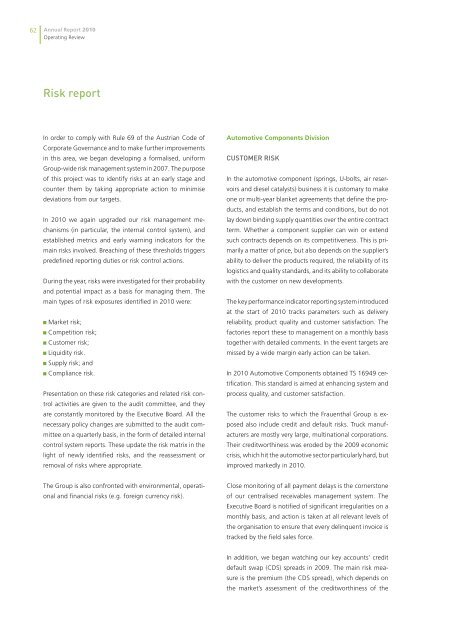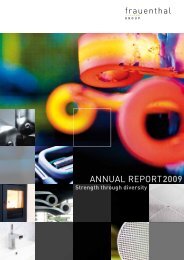Annual Report 2010 - Frauenthal Holding AG
Annual Report 2010 - Frauenthal Holding AG
Annual Report 2010 - Frauenthal Holding AG
You also want an ePaper? Increase the reach of your titles
YUMPU automatically turns print PDFs into web optimized ePapers that Google loves.
62 <strong>Annual</strong> <strong>Report</strong> <strong>2010</strong><br />
Operating Review<br />
risk report<br />
In order to comply with Rule 69 of the Austrian Code of<br />
Corporate Governance and to make further improvements<br />
in this area, we began developing a formalised, uniform<br />
Group-wide risk management system in 2007. The purpose<br />
of this project was to identify risks at an early stage and<br />
counter them by taking appropriate action to minimise<br />
deviations from our targets.<br />
In <strong>2010</strong> we again upgraded our risk management mechanisms<br />
(in particular, the internal control system), and<br />
established metrics and early warning indicators for the<br />
main risks involved. Breaching of these thresholds triggers<br />
predefined reporting duties or risk control actions.<br />
During the year, risks were investigated for their probability<br />
and potential impact as a basis for managing them. The<br />
main types of risk exposures identified in <strong>2010</strong> were:<br />
Market risk;<br />
Competition risk;<br />
Customer risk;<br />
Liquidity risk.<br />
Supply risk; and<br />
Compliance risk.<br />
Presentation on these risk categories and related risk control<br />
activities are given to the audit committee, and they<br />
are constantly monitored by the Executive Board. All the<br />
necessary policy changes are submitted to the audit committee<br />
on a quarterly basis, in the form of detailed internal<br />
control system reports. These update the risk matrix in the<br />
light of newly identified risks, and the reassessment or<br />
removal of risks where appropriate.<br />
The Group is also confronted with environmental, operational<br />
and financial risks (e.g. foreign currency risk).<br />
Automotive Components Division<br />
CuStoMer riSk<br />
In the automotive component (springs, U-bolts, air reservoirs<br />
and diesel catalysts) business it is customary to make<br />
one or multi-year blanket agreements that define the products,<br />
and establish the terms and conditions, but do not<br />
lay down binding supply quantities over the entire contract<br />
term. Whether a component supplier can win or extend<br />
such contracts depends on its competitiveness. This is primarily<br />
a matter of price, but also depends on the supplier’s<br />
ability to deliver the products required, the reliability of its<br />
logistics and quality standards, and its ability to collaborate<br />
with the customer on new developments.<br />
The key performance indicator reporting system introduced<br />
at the start of <strong>2010</strong> tracks parameters such as delivery<br />
reliability, product quality and customer satisfaction. The<br />
factories report these to management on a monthly basis<br />
together with detailed comments. In the event targets are<br />
missed by a wide margin early action can be taken.<br />
In <strong>2010</strong> Automotive Components obtained TS 16949 certification.<br />
This standard is aimed at enhancing system and<br />
process quality, and customer satisfaction.<br />
The customer risks to which the <strong>Frauenthal</strong> Group is exposed<br />
also include credit and default risks. Truck manufacturers<br />
are mostly very large, multinational corporations.<br />
Their creditworthiness was eroded by the 2009 economic<br />
crisis, which hit the automotive sector particularly hard, but<br />
improved markedly in <strong>2010</strong>.<br />
Close monitoring of all payment delays is the cornerstone<br />
of our centralised receivables management system. The<br />
Executive Board is notified of significant irregularities on a<br />
monthly basis, and action is taken at all relevant levels of<br />
the organisation to ensure that every delinquent invoice is<br />
tracked by the field sales force.<br />
In addition, we began watching our key accounts’ credit<br />
default swap (CDS) spreads in 2009. The main risk measure<br />
is the premium (the CDS spread), which depends on<br />
the market’s assessment of the creditworthiness of the




